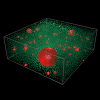Drying Complex Suspensions
Mixtures of immiscible fluids with colloids can be very complex but they are technologically important for industries such as paints and protective coatings, especially when such materials undergo drying. Emulsions containing colloidal particles are particularly interesting as controllable test cases of such systems, but they are difficult to image because these mixtures typically scatter light strongly. Lei Xu, Alexis Bergès, myself and others describe a full 3D picture of what happens when these emulsions dry out. We mix a suspensions of 1-micron polymethylmethacrylate spheres (dyed green) in decahydronaphthalene with an aqueous emulsion of water and glycerol, plus a surfactant to stabilize the water droplets (dyed red). We obtain pictures of this concoction with a confocal microscope, which captures very thin slices of the sample that can be built up into high-resolution 3D images. As the mixture dries on a microscope slide, two different behaviors emerge: large droplets evacuate quickly, whereas small droplets undergo shape changes yet remain essentially intact. We explain the rates of evacuation, and the threshold droplet size for the two behaviors, with a simple model coupling the Laplace pressure to Darcy’s Law for flow through a porous medium.
Publications
- Lei Xu et al., “Drying of Complex Suspensions” Physical Review Letters. 104, 128303 (2010). [pdf]
Additional Links
- APS Physics (Mar 2010)

